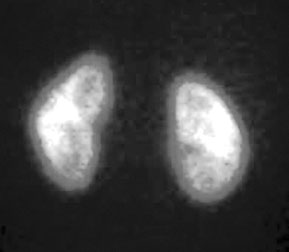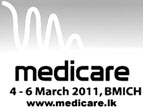|

Nuclear medicine
Best example for human friendly use of nuclear
energy:
by Shyamal INDIKE DE SILVA
 |
|
Myocardial Perfusion
Scan |
Have you ever heard of Nuclear Medicine? No doubt you must be
familiar with the words "Nuclear bombs" or "Nuclear reactors". But, what
do we know about Nuclear Medicine?
Nuclear Medicine is a vast field in the medical world. But
unfortunately this special field's popularity is almost limited to the
western and many other developed countries. But even in our neighbouring
countries such as India, Pakistan and Nepal this is widely used.
Nuclear Medicine is basically for diagnostic as well as the treatment
purposes.
This is widely used to screen estimate functions of organs and
structures in the body. And also to analyze human blood samples to assay
hormone levels. It also covers the treatment of hyperthyroidism, thyroid
carcinoma and as a pain relief in cancer patients.
The field of Nuclear Medicine part can be divided mainly in to two,
such as in- vivo and in-vitro. In vivo is the imaging part of the field
as In-vitro brings us the finest blood hormonal tests, pain relief
treatment, thyroid gland treatment and cancer treatment.
Nuclear Medicine differs from radiology as these scans call
transmitting scans (means patient is the radiation source) and all the
other radiology scans are transparent scans (means using an external
source to expose patient for the scan). Nuclear images are of two
categories.
That is functional images and static images. For many of the cases
nuclear medicine give the final answer and it reflects the popularity of
this field all over the world.
In Nuclear Medicine imaging, trace amounts of radio isotopes (some
selected unstable chemical elements which emit gamma rays) mixed with
non radioactive pharmaceuticals are used.
It travels through the blood stream to the particular areas or organs
of the body and emits rays which in turn is captured by a special
machine called gamma camera. Currently Technetium (Tc99m) and Iodine
(131I) isotopes are popular.
But in the past many other isotopes have been used for this
purpose.Can we do scans by injecting pure isotopes? The answer is 'yes'
but only for some scans.
 |
|
DMSA Renal Scan Image
(A Static Kidney Scan) |
(Eg. Thyroid scans, gastric emptying scans). For other scans
previously mentioned non-radioactive pharmaceuticals should be mixed and
they are the carriers of radio isotope to the targeted organs or areas
of the body.
Normally these pharmaceuticals are naturally attractive chemicals to
the specific organ which we are interesting. (Eg. thyroid gland likes
iodine and we use same iodine but in radioactive isotope form).
When we combine pharmaceutical with gamma emitting radio isotope and
administer intravenously or by orally it goes directly and locate in the
cells of particular organ.
That is how it provides us cellular level information. Why is this
cellular level information important? Because of any defect or any
disease begins first in cells of the particular organ.
While imaging the gamma camera receives these transmitting gamma rays
and it creates the images in its computers.
Whether it is dynamic or static scan basic theory is the same.
These scan information is quite different from the other scans as
they are more specific and informal for early diagnosis.
In-vitro side of the nuclear medicine includes the treatment and pain
killing sides in patients. We can administer Iodine (I131) as a
treatment, especially for thyroid cancer patients who are suffering from
thyroid carcinoma and 'thyrotoxicosis' (excessive production of
thyroxine by the thyroid gland- also called hyperthyroidism).
For thyroid excessive cancer we give high therapy doses such as
100mCi or 200mCi to kill cancer cells in the gland.
To control production of thyroid hormones we administer around 10mCi
to reduce the function of the gland.
This is called the treatment dose to the hyperthyroidism.
Either after the first dose or second, a nuclear medicine scan can be
performed without administering extra doses to the patient for future
references. For pain management for end stage cancer patients Isotope
called phosphorous (P32) is costly but an effective solution.
In contrast, Nuclear Medicine is a highly interesting area in the
medical field which gives a lot of benefit the patients by submitting
final and specific details to the doctor.
 |
|
A Tc99m Thyroid Scan
Image |
At present nuclear medicine has developed to the next generation
called PET (Positron Emitting Tomography) images and popular in many
countries.
In Sri Lanka, we are still one generation behind PET, with SPECT
(Single Photo Electron Computerized Tomography) gamma cameras.
One SPECT tomography Dual head (Dual detector) gamma camera and four
single Detector gamma cameras are available in Sri Lanka. One private
hospital and four other government institutes facilitate this service in
the island.
One of the main reasons to slowdown the implementation of Nuclear
Medicine facilities in Sri Lanka is the unavailability of
radio-pharmaceutical production and radio isotope factories in our own
as this is a byproduct of nuclear reactors.
But still it is feasible to import and use these items if we have a
very efficient system to handle as the radio isotopes are constantly
decaying with time.
When we talk about our country, the nuclear medicine history goes
back to 1972 when late Dr. Rienziel Piyasena one who graced our country
by chairing a former top post in IAEA (International Atomic Energy
Agency- Vienna) founded the Nuclear Medicine Dept. in University of
Peradeniya (He is the person who helped to start this technique in many
other countries).
This is the only department in Sri Lanka which covers both in-vitro
and in-vivo fields under one roof even now. Along with late Prof. T.W.
Wikramanayake he has started radio-immunoassay techniques as the pioneer
head of the department.
For the in-vitro field, still only two other centres are functional
in the country. Peradeniya, Sri Lanka's first Nuclear Medicine
department now has taken steps to include this subject in medical
degrees and postgraduate degrees of Sri Lanka.
In summing up, I feel this marvellous field should be popularised
within the medical community and spread all over the country like in
other countries to give a valuable healthcare service to our people.
This is one of the best examples of using creative techniques of nuclear
energy in a very useful, peaceful and harmless manner for the betterment
of human beings.
(The writer is the Nuclear Medicine Technologist, Lanka Hospitals)
Contraceptive supply and unintended pregnancies
Rates of unintended pregnancies and abortions decrease significantly
when women receive a one-year supply of oral contraceptives, instead of
being prescribed one-or three-month supplies, a UCSF study shows.
 Researchers observed a 30 percent reduction in the odds of pregnancy
and a 46 percent decrease in the odds of an abortion in women given a
one-year supply of birth control pills at a clinic versus women who
received the standard prescriptions for one - or three-month supplies. Researchers observed a 30 percent reduction in the odds of pregnancy
and a 46 percent decrease in the odds of an abortion in women given a
one-year supply of birth control pills at a clinic versus women who
received the standard prescriptions for one - or three-month supplies.
The researchers speculate that a larger supply of oral contraceptive
pills may allow more consistent use, since women need to make fewer
visits to a clinic or pharmacy for their next supply.
"Women need to have contraceptives on hand so that their use is as
automatic as using safety devices in cars, "said Diana Greene Foster,
PhD, lead author and associate professor in the UCSF Department of
Obstetrics, Gynaecology and Reproductive Sciences. "Providing one cycle
of oral contraceptives at a time is similar to asking people to visit a
clinic or pharmacy to renew their seatbelts each month."
Foster also is director of research for Advancing New Standards in
Reproductive Health, part of the UCSF Bixby Center for Global
Reproductive Health.
The researchers linked 84,401 women who received oral contraceptives
in January 2006 through Family PACT (Planning, Access, Care, Treatment),
a California family planning program, to Medi-Cal data showing
pregnancies and births in 2006.
Through Family PACT, some family planning clinics are able to
dispense a one-year supply of pills on-site.Oral contraceptive pills are
the most commonly used method of reversible contraception in the United
States, the team states. While highly effective when used correctly
(three pregnancies per 1,000 women in the first year of use),
approximately half of women regularly miss one or more pills per cycle,
a practice associated with a much higher pregnancy rate (80 pregnancies
per 1,000 women in the first year of use), according to the team.The
findings of this study have implications for women using oral
contraceptives across the country.
Most oral contraceptive users in the United States get fewer than
four packs at a time; nearly half need to return every month for
resupply, according to a 2010 study published in Contraception.
Making oral contraceptive pills more accessible may reduce the
incidence of unintended pregnancy and abortion, while saving taxpayers'
dollars, the researchers state.
If the 65,000 women in the analysis who received either one or three
packs of pills at a time had experienced the same pregnancy and abortion
rates as women who received a one-year supply, almost 1,300 publicly
funded pregnancies and 300 abortions would have been averted, according
to the team. "The evidence indicates that health plans and public health
programs may avoid paying for costly unintended pregnancies by
increasing dispensing limits on oral contraceptives," said Foster.
"Improving access to contraceptive methods reduces the need for abortion
and helps women to plan their pregnancies."
Source: Karin Rush-Monroe University of California - San Francisco
MEDICARE 2011:
Asian miracle in healthcare
by Nilma DOLE
The one-of-a-kind medical exhibition - and convention sponsored by
the Sunday Observer, Medicare 2011 ends today. Chairman of the
Organising Committee Dr. Amal Harsha de Silva said that Sri Lanka has
created an Asian miracle in healthcare by holding this National
Healthcare Exhibition.
He said, "Our infant mortality and maternal mortality rates are on
par with the developed world and it is definitely above all our
neighbouring countries. We are providing free healthcare to our people
at the point of delivery."
The Medicare exhibition will be held for the second consecutive year,
organised by the Department of Health - Western Province under the
patronage of the Ministry of Health. "We have a unique aspect in this
exhibition where we invited all health ministers, past and present, to
come together on one platform to make this exhibition a reality.
We work on common ground to exchange ideas and knowledge on one
platform because health is a national issue and we need to work together
to make our country a healthy nation," he said.
Health and health technological advances are now significantly
becoming bigger and better and it is with such aims that this medical
exhibition will cater. "Our goal is to ensure that the public is getting
timely, accurate and important information with regard to health issues
and to be updated on the latest technological innovations pertaining to
health.
This in turn, will promote a healthy lifestyle for the benefit of
all," said Dr. De Silva.
The key features of this exhibition is that it will have various
seminars from professionals and doctors in the medical industry and it
will also have medical equipment from genuine and authentic service and
product providers. "Medical professionals can also get updated on the
latest time-tested technologies available at the National Healthcare
Exhibition. Whilst at the same time, we are having some key interactive
events between the public and healthcare providers," said the doctor.
He said, "We would promote good doctor-patient relationships and
allow other professionals to see how best they can help each
other."Medicare 2011 will have a unique feature as the year 2011 has
been declared the 'Visit Sri Lanka' year where plenty of tourists and
Sri Lankans living abroad will discover and rediscover our peaceful
nation.
What's more, rather than just offering traditional tourism, Sri
Lanka's medical tourism is quickly gaining recognition and it's safe to
say that plenty of medical professionals are now thought of as examples
for others to follow.
"Our health indicators are on par with the West such as maternal
health, life expectancy, etc. Sri Lanka is not being seen as an example
and outlines among neighbouring countries such as India, Pakistan,
Bangladesh and the Maldives. Our professionals have experience tackling
a variety of medical problems. Both public and private sector, have
improved drastically within the past two decades," said Dr. de Silva.
"Our advice is to get the public to tell us what they want to hear
and give us the strength to help them help themselves. You can't always
buy the best medical knowledge so we must ensure that the right message
is going to the right patient," he said.
 The Chairman of the organising committee said that we are creating a
brain gain with the conditions looking favourable for health policy
strengthening after the dawn of peace. "It is safe to say that even Sri
Lankan expatriates and foreigners are now becoming highly impressed with
our healthcare and especially since it's all for free," he said. The Chairman of the organising committee said that we are creating a
brain gain with the conditions looking favourable for health policy
strengthening after the dawn of peace. "It is safe to say that even Sri
Lankan expatriates and foreigners are now becoming highly impressed with
our healthcare and especially since it's all for free," he said.
Dr. de Silva said, "Education and awareness is the key to having a
healthy nation and the Medicare 2011 exhibition is important on how best
us doctors can help you help yourself!"
Tomatoes, the new superfood
Eating more tomatoes and tomato products can make people healthier
and decrease the risk of conditions such as cancer, osteoporosis and
cardiovascular disease, according to a review article the American
Journal of Lifestyle Medicine, (published by SAGE).
Of all the non-starchy vegetables, Americans eat more tomatoes and
tomato products than any others. Researchers Britt Burton-Freeman, PhD,
MS, and Kristin Reimers, PhD, RD of the National Center for Food Safety
and Technology, Illinois Institute of Technology and ConAgra Foods,
Inc., looked at the current research to discover the role tomato
products play in health and disease risk reduction.
 The researchers found that tomatoes are the biggest source of dietary
lycopene; a powerful antioxidant that, unlike nutrients in most fresh
fruits and vegetables, has even greater bioavailability after cooking
and processing. Tomatoes also contain other protective mechanisms, such
as antithrombotic and anti-inflammatory functions. Research has
additionally found a relationship between eating tomatoes and a lower
risk of certain cancers as well as other conditions, including
cardiovascular disease, osteoporosis, ultraviolet light-induced skin
damage, and cognitive dysfunction. The researchers found that tomatoes are the biggest source of dietary
lycopene; a powerful antioxidant that, unlike nutrients in most fresh
fruits and vegetables, has even greater bioavailability after cooking
and processing. Tomatoes also contain other protective mechanisms, such
as antithrombotic and anti-inflammatory functions. Research has
additionally found a relationship between eating tomatoes and a lower
risk of certain cancers as well as other conditions, including
cardiovascular disease, osteoporosis, ultraviolet light-induced skin
damage, and cognitive dysfunction.
Tomatoes are widely available, people of all ages and cultures like
them, they are cost-effective, and are available in many forms.
"Leveraging emerging science about tomatoes and tomato products may
be one simple and effective strategy to help individuals increase
vegetable intake, leading to improved overall eating patterns, and
ultimately, better health," write the authors.
"Tomatoes are the most important non-starchy vegetable in the
American diet. Research underscores the relationship between consuming
tomatoes and reduced risk of cancer, heart disease, and other
conditions," the authors conclude.
"The evidence also suggests that consumption of tomatoes should be
recommended because of the nutritional benefits and because it may be a
simple and effective strategy for increasing overall vegetable intake.
"The article is particularly timely since the recently released
Dietary Guidelines for Americans 2010 moved tomatoes to a newly
established category of "orange/red" fruits and vegetables to encourage
higher consumption of these healthy foods.
(Source: Ashley Wrye SAGE Publications)
|

